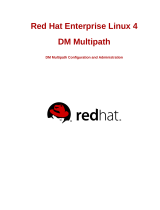Table of contents
3 Dell EMC PowerVault ME4 Series and Linux | 3924-BP-L
Table of contents
Revisions............................................................................................................................................................................. 2
Acknowledgements ............................................................................................................................................................. 2
Table of contents ................................................................................................................................................................ 3
Executive summary ............................................................................................................................................................. 5
Audience ............................................................................................................................................................................. 5
1 ME4 Series overview .................................................................................................................................................... 6
1.1 Hardware features .............................................................................................................................................. 6
1.2 Software features................................................................................................................................................ 6
1.2.1 Virtual and linear storage .................................................................................................................................... 6
1.2.2 RAID data protection levels ................................................................................................................................ 6
1.2.3 Thin provisioning................................................................................................................................................. 7
1.2.4 Automated tiered storage ................................................................................................................................... 7
1.2.5 Snapshots ........................................................................................................................................................... 7
1.2.6 Replication .......................................................................................................................................................... 7
1.2.7 Full-disk encryption ............................................................................................................................................. 7
1.2.8 ME Storage Manager ......................................................................................................................................... 7
1.2.9 Command-line interface ..................................................................................................................................... 8
2 Connectivity considerations .......................................................................................................................................... 9
2.1 Direct-attached storage ...................................................................................................................................... 9
2.2 SAN-attached storage ........................................................................................................................................ 9
2.2.1 Fibre Channel ..................................................................................................................................................... 9
2.2.2 iSCSI ................................................................................................................................................................. 12
3 Linux setup and configuration .................................................................................................................................... 16
3.1 Discover and identify ME4 Series volumes ...................................................................................................... 16
3.1.1 Scan and identify new volumes on Linux ......................................................................................................... 16
3.1.2 Scan LUN 0 ...................................................................................................................................................... 16
3.1.3 Identify ME4 Series volumes on Linux ............................................................................................................. 17
3.2 Multipathing ...................................................................................................................................................... 22
3.2.1 Native Linux multipath (device-mapper-multipath) ........................................................................................... 22
3.2.2 Configure multipath for ME4 Series storage .................................................................................................... 23
3.2.3 Asymmetric Logic Unit Access ......................................................................................................................... 24
3.3 LUN partition ..................................................................................................................................................... 24
3.4 Linux LVM ......................................................................................................................................................... 25
3.4.1 LVM guidelines ................................................................................................................................................. 25





















